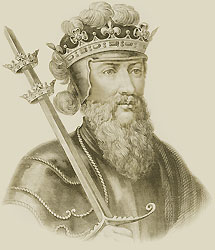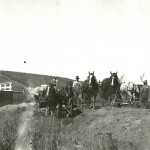hail
 Before scientists learned how to predict the weather, and before the weather predicting equipment came into being, people often found themselves outside, without any place to get under cover, during some really bad storms. Such was the case on Monday, April 13, 1360…later dubbed Black Monday, when a hail storm killed approximately 1,000 English soldiers in Chartres, France. England and France were in the middle of the Hundred Years’ War. The war began in 1337, and by 1359, King Edward III of England was pushing forward to conquer France. In October he sent a massive force across the English Channel to Calais. The French wouldn’t fight back, but rather stayed behind protective walls that Winter, allowing the King Edward’s men to pillage the countryside.
Before scientists learned how to predict the weather, and before the weather predicting equipment came into being, people often found themselves outside, without any place to get under cover, during some really bad storms. Such was the case on Monday, April 13, 1360…later dubbed Black Monday, when a hail storm killed approximately 1,000 English soldiers in Chartres, France. England and France were in the middle of the Hundred Years’ War. The war began in 1337, and by 1359, King Edward III of England was pushing forward to conquer France. In October he sent a massive force across the English Channel to Calais. The French wouldn’t fight back, but rather stayed behind protective walls that Winter, allowing the King Edward’s men to pillage the countryside.
Then in April of 1360 King Edward’s forces burned the Paris suburbs and marched  toward Chartres. The night of April 13, while they were camped outside the town, planning a dawn attack, a sudden storm developed. Lightning struck, killing several soldiers, and hailstones began pelting the men, and scattering the horses. One man described it as “a foul day, full of myst and hayle, so that the men dyed on horseback” Two of the English leaders were killed and the troops panicked…they had no shelter from the storm. They were at it’s mercy. King Edward’s forces suffered heavy losses that some of the men saw as a sign from God, that they should not be fighting against France. King Edward was convinced that they needed to negotiate peace with the French, and on May 8, 1360, the Treaty of Bretigny was signed, marking the end of the first phase of the Hundred Years’ War. King Edward renounced all claims to the throne of France, but he was given control of the land in the north of the country. Nine years later, fighting resumed
toward Chartres. The night of April 13, while they were camped outside the town, planning a dawn attack, a sudden storm developed. Lightning struck, killing several soldiers, and hailstones began pelting the men, and scattering the horses. One man described it as “a foul day, full of myst and hayle, so that the men dyed on horseback” Two of the English leaders were killed and the troops panicked…they had no shelter from the storm. They were at it’s mercy. King Edward’s forces suffered heavy losses that some of the men saw as a sign from God, that they should not be fighting against France. King Edward was convinced that they needed to negotiate peace with the French, and on May 8, 1360, the Treaty of Bretigny was signed, marking the end of the first phase of the Hundred Years’ War. King Edward renounced all claims to the throne of France, but he was given control of the land in the north of the country. Nine years later, fighting resumed  when the King of France claimed that King Edward had not honored the treaty. the last phase of the Hundred Years’ War finally ended in 1453.
when the King of France claimed that King Edward had not honored the treaty. the last phase of the Hundred Years’ War finally ended in 1453.
Hailstones have long been known to be very deadly. The larger the stone, of course, the more deadly it is. Some have been known to crush the roofs of cars. The largest hailstone recorded in modern times was found in Aurora, Nebraska. It was seven inches in diameter, about the size of a soccer ball. Hail typically falls at about 100 miles per hour, which explains why getting hit with one can really hurt you, no matter how small the stone might be, and why huge hailstones would mean instant death.
 For any one whose ancestors came out to the West, homesteading probably is a word we know, and something we know a little about. Even if it is back in the history of our family, we knew that yes, the land was given to the homesteader, but in reality, they earned every blade of grass that was on their homestead. Homesteading was no easy way to live. Homesteading began when the United States government decided to give 65 acres to anyone who wanted to move out west and settle. They had to work the land for 5 years and then it became theirs. This all sounded like an amazing opportunity to many people, but there were many who came out west to get a homestead and then went back home before the 5 year timeframe was passed. They just couldn’t make it. The didn’t have what it takes. Homesteading was not a lazy man’s way to get land. This land was hard and full of rocks and trees. It had not been plowed and planted before. They would be the first to do that, and they didn’t have all the equipment we have these days to plow up the hard soil so it was suitable for growing crops on.
For any one whose ancestors came out to the West, homesteading probably is a word we know, and something we know a little about. Even if it is back in the history of our family, we knew that yes, the land was given to the homesteader, but in reality, they earned every blade of grass that was on their homestead. Homesteading was no easy way to live. Homesteading began when the United States government decided to give 65 acres to anyone who wanted to move out west and settle. They had to work the land for 5 years and then it became theirs. This all sounded like an amazing opportunity to many people, but there were many who came out west to get a homestead and then went back home before the 5 year timeframe was passed. They just couldn’t make it. The didn’t have what it takes. Homesteading was not a lazy man’s way to get land. This land was hard and full of rocks and trees. It had not been plowed and planted before. They would be the first to do that, and they didn’t have all the equipment we have these days to plow up the hard soil so it was suitable for growing crops on.
My grandparent were among those who came out and earned that homestead, by working that land and making it grow the crops they wanted it to grow. I doubt that they got by without ever losing a crop, because hail, drought, flood, fire, and tornados were bound to have happened at least once during that 5 year timeframe, but they stuck it out and made it work. They proved that they were tough enough to earn that homestead…to the government and to themselves.
Now, don’t get me wrong, I don’t think that the ones that went home were no good, they just didn’t have what it took to make it in the old west. This was rough country, and you  had to be tough to stick it out here. They had to learn to get along with the Indians too, because the Indians weren’t real happy with the White Man being here at all. Treaties had been broken to allow the west to be settled, and they didn’t like it one bit. I think we can all agree that this country was going to expand one way or the other, because as people have children and those children have children, and those children have children, and so on…well, more space was bound to be needed. Still, I suppose we should have handled it in a different way. Nevertheless, many White Men made peace with the Indians, and learned to live together. The White Man had come to the West. He was here to stay, because he had earned that homestead.
had to be tough to stick it out here. They had to learn to get along with the Indians too, because the Indians weren’t real happy with the White Man being here at all. Treaties had been broken to allow the west to be settled, and they didn’t like it one bit. I think we can all agree that this country was going to expand one way or the other, because as people have children and those children have children, and those children have children, and so on…well, more space was bound to be needed. Still, I suppose we should have handled it in a different way. Nevertheless, many White Men made peace with the Indians, and learned to live together. The White Man had come to the West. He was here to stay, because he had earned that homestead.

